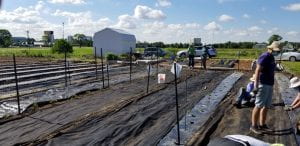
It is commendable that The Ohio State University has identified food insecurity, particularly in urban areas of Ohio, as an issue which must be more vigorously addressed by various units of one of the country’s largest and most comprehensive research universities. In the coming years, tens of millions of dollars will be dedicated by OSU to address this complex issue in Ohio and beyond.
If we are to be successful in not just addressing this complex issue, but making real progress towards mitigating some of the phenomena which causes food insecurity in the United States, it will be imperative for us to completely understand the issue.
I recently guest-lectured for an OSU class on food justice and food security. The undergraduate and graduate students in the class were very interested in addressing food insecurity, particularly in urban neighborhoods of Columbus, and asked me how the food system in the United States should be changed to address this issue.
Instead of answers, I gave the students more questions. The discussion went something like this:
Me: Why are some residents in urban neighborhoods in Columbus food insecure?
Students: Because some families don’t have enough money to buy food.
Me: Why don’t some families have enough money to buy food?
Students: Because they are unemployed.
Me: Why are some people in Columbus unemployed when we have some of the lowest unemployment rates in the state, and many jobs are going unfilled due to a shortage of qualified applicants?
Students: Because some people have not had educational, economic, or social opportunities.
Me: Why have some people not had educational, economic, or social opportunities?
Students: Many different reasons, including mental health issues, racial inequality, cultural differences, lack of investment in urban neighborhoods, transportation challenges, etc.
Me: (somewhat rhetorically) So, what type of changes in our food system do you think are needed to address the root causes of food insecurity in urban neighborhoods???
If we expect to make real progress with reducing the incidence of food insecurity in Ohio, in the United States, or in the world for that matter, we simply must discover, acknowledge, and mitigate the actual causes of food insecurity. It seems to me that most of these causes are rooted in poverty and a lack of economic resources, not in food or the food system. While the food system in the US needs to change and is changing, such changes should not be expected to address the real causes of food insecurity.
In the United States we have been engaged in a war on poverty since the mid 1960’s, when President Lyndon Johnson first declared war on poverty. Identifying the tactics needed to finally win this war will be the key to mitigating food insecurity in urban neighborhoods in Ohio.
Useful documents:
Food Security in the US – USDA
Healthy Food Systems – OSU Extension
 In Columbus, Franklin County Master Gardener Volunteers are addressing food insecurity in neighborhoods throughout the city which are considered food deserts. Franklin MGVs have received exemptions to re-start four food production projects throughout the city and at Waterman Farm on The Ohio State University campus to address the increased level of food insecurity brought on by the pandemic. Franklin MGVs maintain 72 ongoing projects throughout the community. During the 2019 growing season they produced and donated 21,425 pounds of vegetables, fruit, and herbs to dozens of neighborhood food pantries in Columbus. Franklin County MGVs help maintain community gardens, urban farms, and two public fruit parks throughout the city. During 2019, 235 MGVs in Franklin County donated 16,811 volunteer hours in the community. Follow this link to learn more.
In Columbus, Franklin County Master Gardener Volunteers are addressing food insecurity in neighborhoods throughout the city which are considered food deserts. Franklin MGVs have received exemptions to re-start four food production projects throughout the city and at Waterman Farm on The Ohio State University campus to address the increased level of food insecurity brought on by the pandemic. Franklin MGVs maintain 72 ongoing projects throughout the community. During the 2019 growing season they produced and donated 21,425 pounds of vegetables, fruit, and herbs to dozens of neighborhood food pantries in Columbus. Franklin County MGVs help maintain community gardens, urban farms, and two public fruit parks throughout the city. During 2019, 235 MGVs in Franklin County donated 16,811 volunteer hours in the community. Follow this link to learn more.